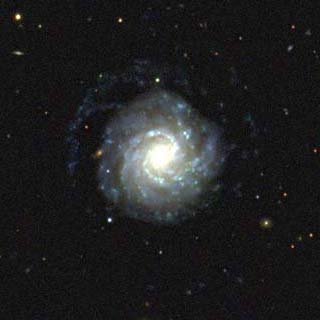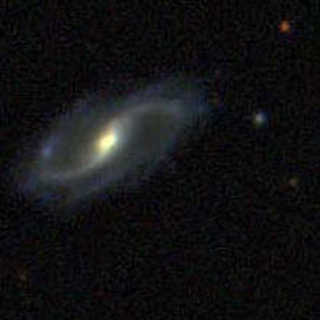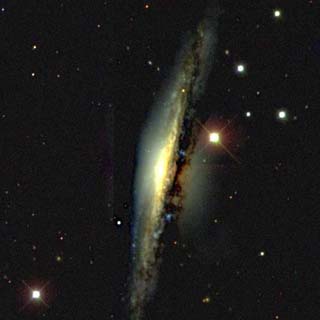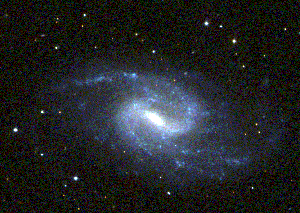Not surprisingly, spiral galaxies look like spirals, with long arms winding toward a bright bulge at the center. But be careful – if you looked at a spiral galaxy from the side, you could mistake its shape for a circle, and so you’d have to use other criteria to learn it was a spiral.
If you can clearly see the spiral shape, the galaxy is called a “face-on spiral.” If you instead see the galaxy from the side, it is called an “edge-on spiral.” You can recognize edge-on spiral galaxies because you can see their bright central bulges. Face-on and edge-on spiral galaxies aren’t really any different; they only look different because of the angle from which you see them.
Some spiral galaxies have arms that are wound tightly, while other galaxies have very loosely-wound arms. The difference between tightly and loosely wound spirals is a genuine difference between the galaxies, and can be used to classify spirals.
About 77% of the observed galaxies in the universe are spiral galaxies. Our own galaxy, the Milky Way, is a typical spiral galaxy. The images below show three other good examples.



Three contrasting spiral galaxies: a face-on spiral galaxy with tightly wound arms (left), a face-on spiral galaxy with very loose arms (center) and an edge-on spiral galaxy (right)
Some spiral galaxies have a bright line, or bar, running through them. These are called “barred spiral galaxies.” The image below shows a barred spiral galaxy. Galaxies without a bar are simply called “spiral galaxies.”

NGC 3559, a barred spiral
Image courtesy Steve Kent
Spiral galaxies are further classified by how tightly their spiral arms are wound. A galaxy with very tightly wound arms, such the left galaxy in the list above, would be called “type a.” galaxy A “type b” galaxy has more loosely wound arms. A “type c” galaxy (such as the middle one above) has very loosely wound arms. What type do you think the barred spiral to the right would be?
The arms of a spiral galaxy have lots of gas and dust, and they are often areas where new stars are constantly forming. The bulge of a spiral galaxy is composed primarily of old, red stars. Very little star formation goes on in the bulge.
The table below shows the abbreviations that are used for spiral galaxy types.
| Galaxy Type | Description |
|---|---|
| Sa | spiral galaxy, type a |
| Sb | spiral galaxy, type b |
| Sc | spiral galaxy, type c |
| SBa | barred spiral galaxy, type a |
| SBb | barred spiral galaxy, type b |
| SBc | barred spiral galaxy, type c |
